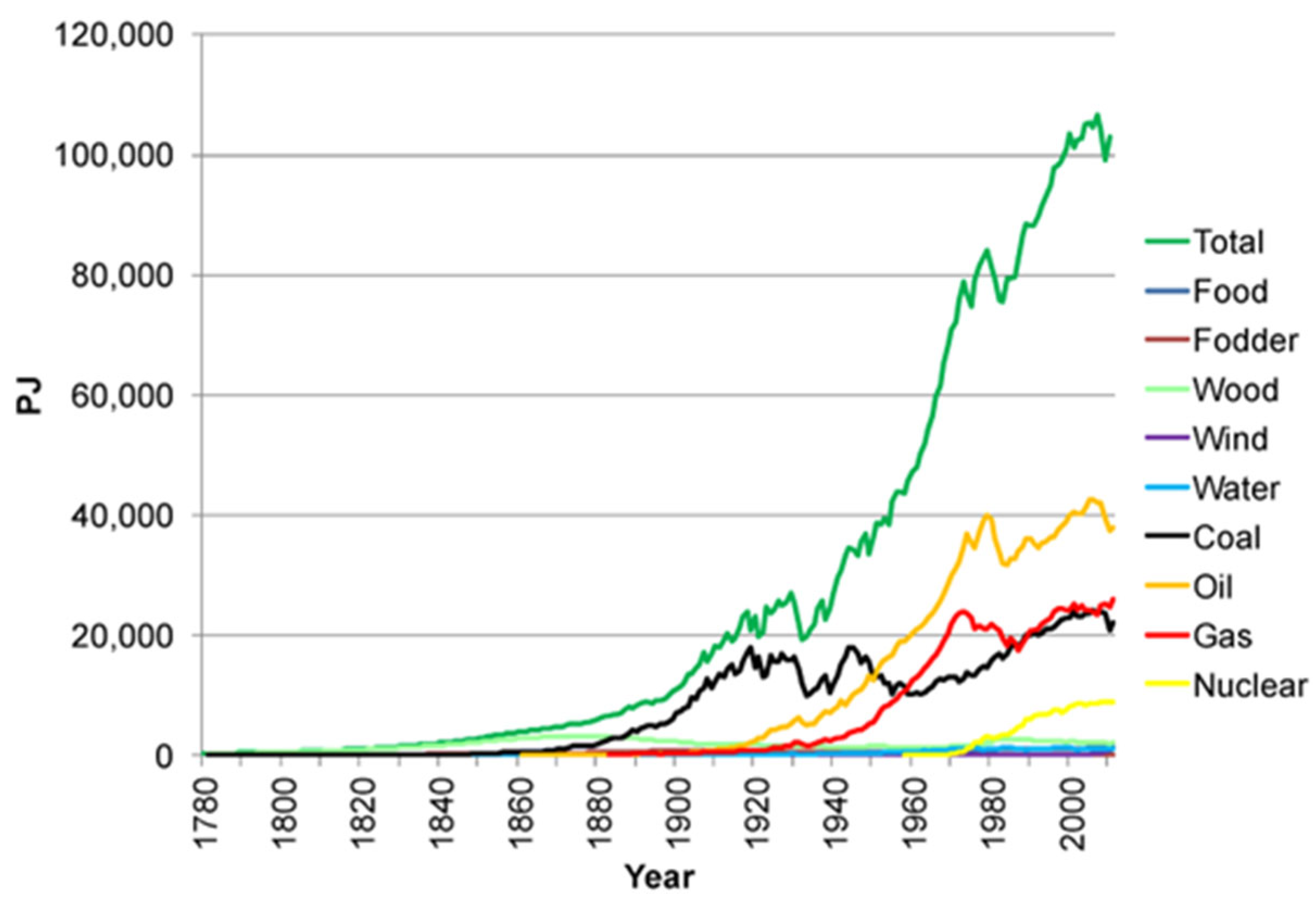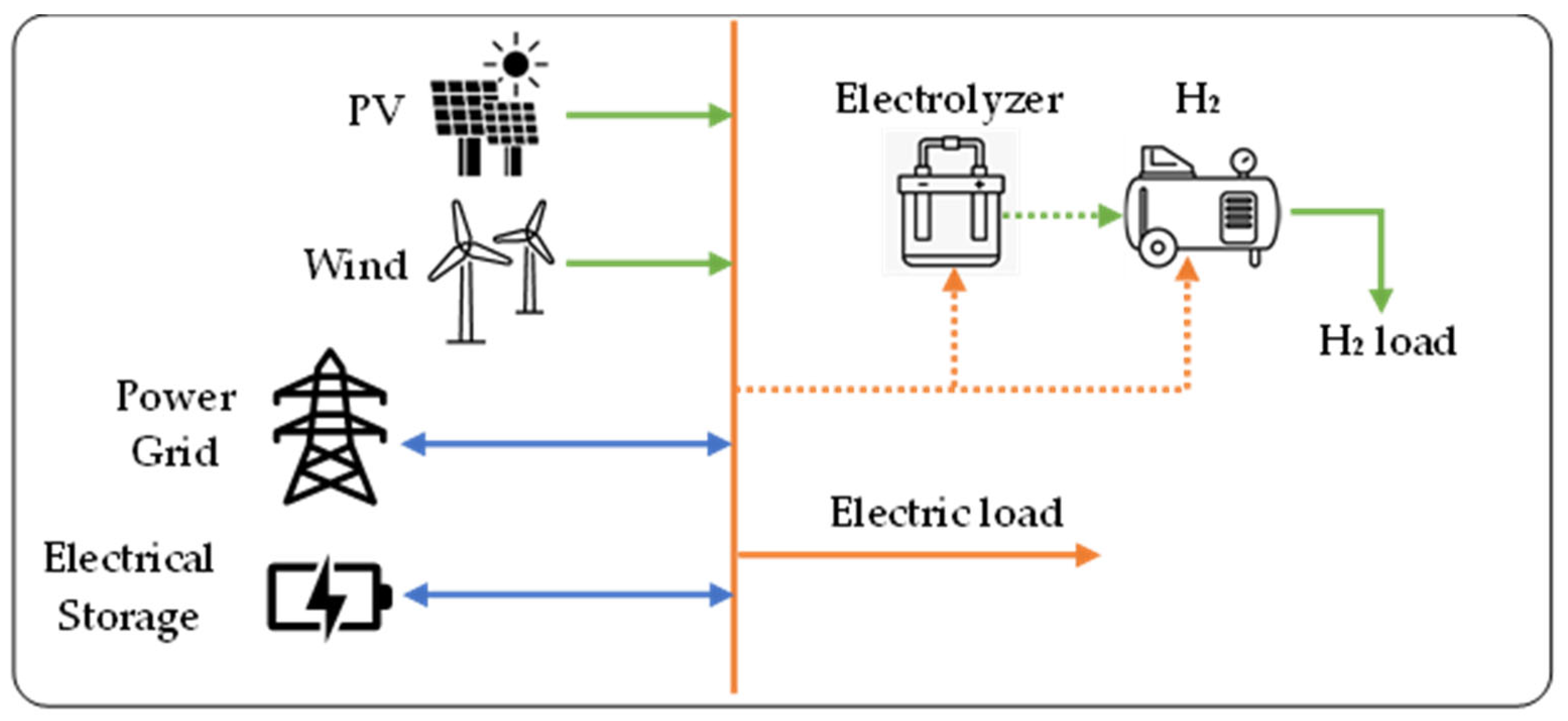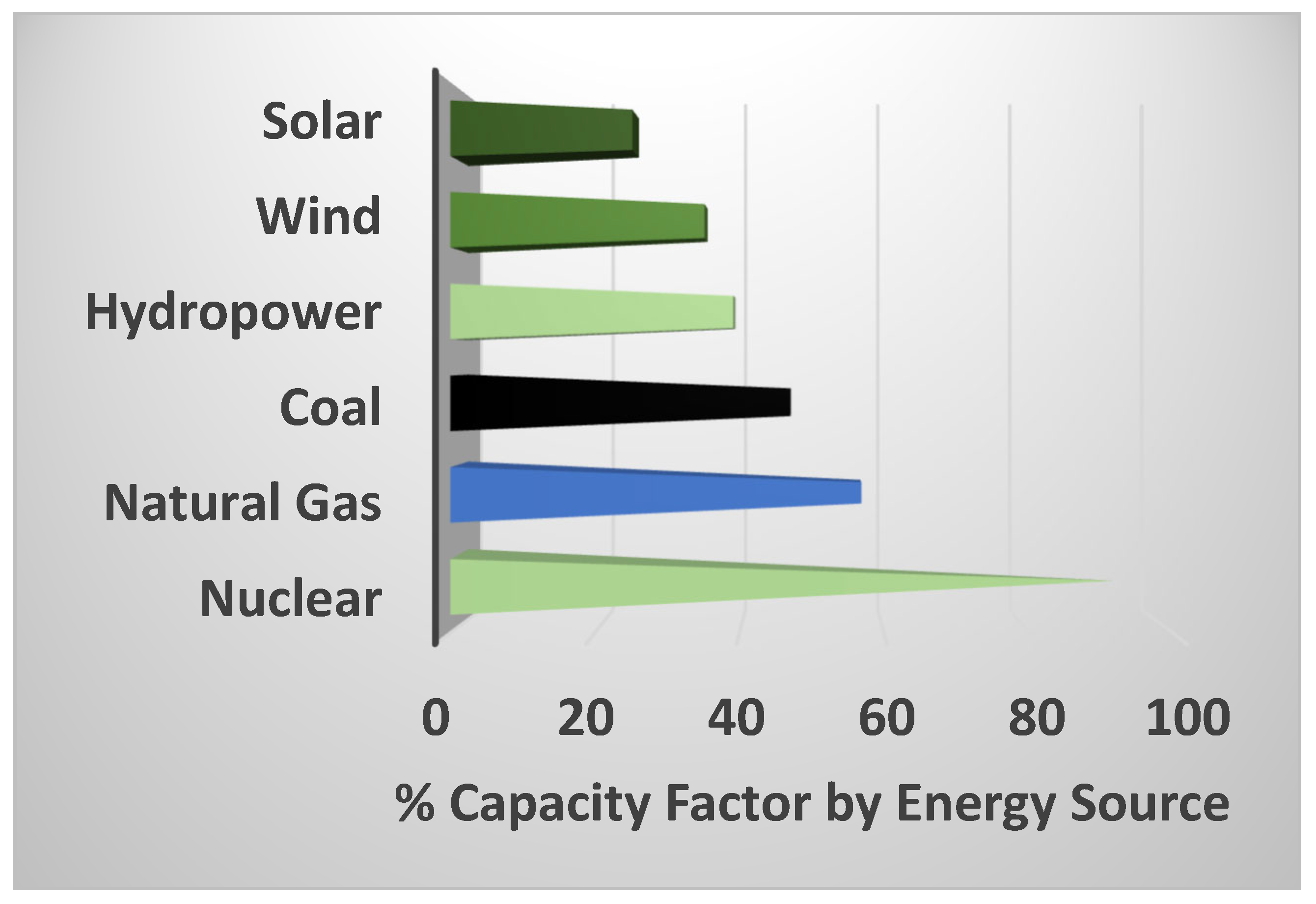Hydrogen, with its potential to decarbonize various sectors, has emerged as a key player in achieving decarbonization and energy sustainability goals. The outlook for hydrogen is characterized by an increasingly central role in the global effort to transition towards a sustainable and low-carbon energy future.
- hydrogen
- energy storage
- energy carrier
- green hydrogen
1. Introduction
2. Historical Energy Transitions
The historical energy transition over the past 200 years has been marked by significant shifts in primary energy sources and technological advancements [37]. The timeline below highlights key phases in this transition (Figure 1). In the pre-industrial era (before 1800 A.D.), human societies relied predominantly on traditional biomass, such as wood and crop residues, for cooking, heating, and basic energy needs [38]. Water and wind power were occasionally utilized for mechanical processes. However, the advent of fossil fuels began in the 18th and 19th centuries. Particularly, the industrial revolution marked a major shift with the widespread use of coal as a primary energy source. Steam engines fueled by coal revolutionized transportation, manufacturing, and agriculture. Then, the rise of oil and gas began in late 19th century. The discovery of oil in the late 19th century and the subsequent development of the oil and gas industry led to a transition away from coal. The internal combustion engine transformed transportation, and oil and natural gas became key sources for heating and electricity generation [39].
3. Role of Hydrogen in Energy Transformation
Hydrogen has gained attention as a clean energy carrier in the 21st century, with a focus on its potential to decarbonize challenging sectors. Advanced technologies, including artificial intelligence, machine learning, and advanced materials, are being leveraged to optimize energy systems and enhance sustainability [47]. Hydrogen possesses unique properties that make it a promising candidate for energy storage in the context of renewable energy integration and grid resilience. Hydrogen has a high energy content (141.86 MJ/kg or 1478.6 Wh/L (@69 Mpa and 25 °C)) [48], making it an efficient energy carrier. This is particularly advantageous for applications where space or weight considerations are critical, such as in transportation or remote energy storage facilities. Hydrogen is versatile in its storage applications [49]. It can be stored as a gas or liquid, and its energy can be converted back into electricity through various methods, including fuel cells and combustion, providing flexibility in how stored energy is utilized. Moreover, hydrogen has the potential for long-duration energy storage [50]. Unlike electrochemical battery technologies that may have limitations in terms of discharge time, hydrogen storage systems can store large quantities of energy for extended periods, making them suitable for addressing fluctuations in renewable energy generation, both daily and seasonally [51]. Hydrogen storage allows for the decoupling of energy production and consumption. Excess energy generated during periods of high renewable energy availability can be used to produce hydrogen through electrolysis, as shown in Figure 3. The dotted lines represent the intermittency associated with a renewable power grid, where excess energy is converted to and stored as hydrogen. This stored hydrogen can then be converted back to electricity when the energy demand is high (for instance, using fuel cells, turbines, etc.). Hydrogen storage systems can be designed to scale according to the energy storage needs of a particular application. This scalability makes hydrogen an adaptable solution for a range of energy storage requirements, from small-scale residential systems to large industrial facilities. Hydrogen storage systems can have relatively low energy losses during the storage and retrieval processes, especially when using advanced technologies such as solid oxide electrolysis cells (SOECs) and high-efficiency fuel cells.
The ongoing efforts to overcome these challenges, coupled with the demonstrated successes and increasing momentum, position hydrogen as a key enabler in achieving a sustainable and resilient energy future. The coming years are poised to witness significant advancements, market expansion, and the establishment of hydrogen as a mainstream primary energy component. In summary, a successful hydrogen energy transition requires a holistic approach that considers technological advancements, infrastructure development, policy support, industry collaboration, cost competitiveness, and public awareness. By addressing these considerations, the global community can pave the way for a sustainable and resilient energy future with hydrogen playing a crucial role in the global energy mix.
References
- International Energy Agency. Net Zero by 2050—A Roadmap for the Global Energy Sector; IEA: Paris, France, 2021; Available online: https://www.iea.org/reports/net-zero-by-2050 (accessed on 21 October 2023).
- Kovač, A.; Paranos, M.; Marciuš, D. Hydrogen in energy transition: A review. Int. J. Hydrogen Energy 2021, 46, 10016–10035.
- Kovač, A. The role of hydrogen in energy transition. Nafta Plin 2022, 41, 57–70.
- Yue, M.; Lambert, H.; Pahon, E.; Roche, R.; Jemei, S.; Hissel, D. Hydrogen energy systems: A critical review of technologies, applications, trends and challenges. Renew. Sust. Energy Rev. 2021, 146, 111180.
- Capurso, T.; Stefanizzi, M.; Torresi, M.; Camporeale, S.M. Perspective of the role of hydrogen in the 21st century energy transition. Energy Convers. Manag. 2022, 251, 114898.
- Noussan, M.; Raimondi, P.P.; Scita, R.; Hafner, M. The role of green and blue hydrogen in the energy transition—A technological and geopolitical perspective. Sustainability 2020, 13, 298.
- Lebrouhi, B.E.; Djoupo, J.J.; Lamrani, B.; Benabdelaziz, K.; Kousksou, T. Global hydrogen development—A technological and geopolitical overview. Int. J. Hydrogen Energy 2022, 47, 7016–7048.
- Martin, A.; Agnoletti, M.F.; Brangier, E. Users in the design of Hydrogen Energy Systems: A systematic review. Int. J. Hydrogen Energy 2020, 45, 11889–11900.
- Salimi, M.; Hosseinpour, M.N.; Borhani, T. The Role of clean hydrogen value chain in a successful energy transition of Japan. Energies 2022, 15, 6064.
- Bhagwat, S.; Olczak, M. Green Hydrogen: Bridging the Energy Transition in Africa and Europe; European University Institute: Fiesole, Italy, 2020.
- Löhr, K.; Matavel, C.E.; Tadesse, S.; Yazdanpanah, M.; Sieber, S.; Komendantova, N. Just energy transition: Learning from the past for a more just and sustainable hydrogen transition in West Africa. Land 2022, 11, 2193.
- Ren, X.; Dong, L.; Xu, D.; Hu, B. Challenges towards hydrogen economy in China. Int. J. Hydrogen Energy 2020, 45, 34326–34345.
- Scheller, F.; Wald, S.; Kondziella, H.; Gunkel, P.A.; Bruckner, T.; Keles, D. Future role and economic benefits of hydrogen and synthetic energy carriers in Germany: A systematic review of long-term energy scenarios. arXiv 2022, arXiv:2203.02834.
- Zhiznin, S.Z.; Timokhov, V.M.; Gusev, A.L. Economic aspects of nuclear and hydrogen energy in the world and Russia. Int. J. Hydrogen Energy 2020, 45, 31353–31366.
- Li, H.X.; Edwards, D.J.; Hosseini, M.R.; Costin, G.P. A review on renewable energy transition in Australia: An updated depiction. J. Clean. Prod. 2020, 242, 118475.
- Gevaert, S.; Pause, L. Green Hydrogen in the Global South: A Literature Review; Utrecht University: Utrecht, The Netherlands, 2022; Available online: https://www.researchgate.net/publication/366809109_Green_Hydrogen_in_the_Global_South_A_literature_review (accessed on 18 October 2022).
- Hjeij, D.; Biçer, Y.; Koç, M. Hydrogen strategy as an energy transition and economic transformation avenue for natural gas exporting countries: Qatar as a case study. Int. J. Hydrogen Energy 2022, 47, 4977–5009.
- Nadaleti, W.C.; de Souza, E.G.; Lourenço, V.A. Green hydrogen-based pathways and alternatives: Towards the renewable energy transition in South America’s regions—Part B. Int. J. Hydrogen Energy 2022, 47, 1–15.
- Razi, F.; Dincer, I. Renewable energy development and hydrogen economy in MENA region: A review. Renew. Sust. Energy Rev. 2022, 168, 112763.
- Palacios, A.; Cordova-Lizama, A.; Castro-Olivera, P.M.; Palacios-Rosas, E. Hydrogen production in Mexico: State of the art, future perspectives, challenges, and opportunities. Int. J. Hydrogen Energy 2022, 47, 30196–30212.
- Razi, F.; Dincer, I. Challenges, opportunities and future directions in hydrogen sector development in Canada. Int. J. Hydrogen Energy 2022, 47, 9083–9102.
- Uyar, T.S.; Bilto, M. Hydrogen related technologies and application a major pathway for the energy transition. In Renewable Energy Based Solutions; Uyar, T.S., Javani, N., Eds.; Springer: Cham, Switzerland, 2022; pp. 643–665.
- Rasul, M.G.; Hazrat, M.A.; Sattar, M.A.; Jahirul, M.I.; Shearer, M.J. The future of hydrogen: Challenges on production, storage and applications. Energy Convers. Manag. 2022, 272, 116326.
- Kar, S.K.; Harichandan, S.; Roy, B. Bibliometric analysis of the research on hydrogen economy: An analysis of current findings and roadmap ahead. Int. J. Hydrogen Energy 2022, 47, 10803–10824.
- Ishaq, H.; Dincer, I.; Crawford, C. A review on hydrogen production and utilization: Challenges and opportunities. Int. J. Hydrogen Energy 2022, 47, 26238–26264.
- Gong, Y.; Yao, J.; Wang, P.; Li, Z.; Zhou, H.; Xu, C. Perspective of hydrogen energy and recent progress in electrocatalytic water splitting. Chin. J Chem. Eng. 2022, 43, 282–296.
- Hermesmann, M.; Müller, T.E. Green, turquoise, blue, or grey? Environmentally friendly hydrogen production in transforming energy systems. Prog. Energy Combust. 2022, 90, 100996.
- Hassan, Q.; Sameen, A.Z.; Salman, H.M.; Jaszczur, M.; Al-Jiboory, A.K. Hydrogen energy future: Advancements in storage technologies and implications for sustainability. J. Energy Storage 2023, 72, 108404.
- Al Ghafri, S.Z.; Munro, S.; Cardella, U.; Funke, T.; Notardonato, W.; Trusler, J.M.; Leachman, J.; Span, R.; Kamiya, S.; Pearce, G.; et al. Hydrogen liquefaction: A review of the fundamental physics, engineering practice and future opportunities. Energy Environ. Sci. 2022, 15, 2690–2731.
- Tarkowski, R.; Uliasz-Misiak, B. Towards underground hydrogen storage: A review of barriers. Renew. Sust. Energy Rev. 2022, 162, 112451.
- Faye, O.; Szpunar, J.; Eduok, U. A critical review on the current technologies for the generation, storage, and transportation of hydrogen. Int. J. Hydrogen Energy 2022, 47, 13771–13802.
- Mahajan, D.; Tan, K.; Venkatesh, T.; Kileti, P.; Clayton, C.R. Hydrogen blending in gas pipeline networks—A review. Energies 2022, 15, 3582.
- Kabeyi, M.J.B.; Olanrewaju, O.A. Sustainable energy transition for renewable and low carbon grid electricity generation and supply. Front. Energy Res. 2022, 9, 1032.
- Valdivia, A.D.; Balcell, M.P. Connecting the grids: A review of blockchain governance in distributed energy transitions. Energy Res. Soc. Sci. 2022, 84, 102383.
- Farias, C.B.B.; Barreiros, R.C.S.; da Silva, M.F.; Casazza, A.A.; Converti, A.; Sarubbo, L.A. Use of hydrogen as fuel: A trend of the 21st century. Energies 2022, 15, 311.
- Avargani, V.M.; Zendehboudi, S.; Saady, N.M.C.; Dusseault, M.B. A comprehensive review on hydrogen production and utilization in North America: Prospects and challenges. Energy Convers. Manag. 2022, 269, 115927.
- World Economic Forum. The 200-Year History of Mankind’s Energy Transitions. 2022. Available online: https://www.weforum.org/agenda/2022/04/visualizing-the-history-of-energy-transitions/ (accessed on 22 June 2023).
- Smil, V. World history and energy. In Encyclopedia of Energy; Cleveland, C.J., Ed.; Elsevier: Amsterdam, The Netherlands, 2004; Volume 6, pp. 549–561.
- Smil, V. Grand Transitions: How the Modern World Was Made; Oxford University Press: Oxford, UK, 2021.
- O’Connor, P.A.; Cleveland, C.J. U.S. Energy Transitions 1780–2010. Energies 2014, 7, 7955–7993.
- Bernabé-Moreno, J. When digitalization becomes an essential part of our energy transition. Digit. Welt 2022, 6, 8–13.
- Zhao, F.; Bai, F.; Liu, X.; Liu, Z. A Review on Renewable Energy Transition under China’s Carbon Neutrality Target. Sustainability 2022, 14, 15006.
- Visualizing the Past and Future of Energy Transitions. Available online: https://www.visualcapitalist.com/sp/visualizing-the-past-and-future-of-energy-transitions/ (accessed on 27 May 2023).
- Capacity Factors for Selected Energy Sources in the United States in 2022. Available online: https://www.statista.com/statistics/183680/us-average-capacity-factors-by-selected-energy-source-since-1998/ (accessed on 21 December 2022).
- Infographic. Capacity Factor by Energy Source. 2019. Available online: https://www.energy.gov/ne/articles/infographic-capacity-factor-energy-source-2019 (accessed on 21 December 2022).
- Solomon, A.A.; Bogdanov, D.; Breyer, C. Curtailment-storage-penetration nexus in the energy transition. Appl. Energy 2019, 235, 1351–1368.
- Gallo, A.B.; Simões-Moreira, J.R.; Costa, H.K.M.; Santos, M.M.; Dos Santos, E.M. Energy storage in the energy transition context: A technology review. Renew. Sust. Energy Rev. 2016, 65, 800–822.
- Züttel, A.; Remhof, A.; Borgschulte, A.; Friedrichs, O. Hydrogen: The future energy carrier. Philos. T. R. Soc. A 2010, 368, 3329–3342.
- Preuster, P.; Alekseev, A.; Wasserscheid, P. Hydrogen storage technologies for future energy systems. Annu. Rev. Chem. Biomol. 2017, 8, 445–471.
- Kharel, S.; Shabani, B. Hydrogen as a long-term, large-scale energy storage solution to support renewables. Energies 2018, 11, 2825.
- Gür, T.M. Review of electrical energy storage technologies, materials and systems: Challenges and prospects for large-scale grid storage. Energy Environ. Sci. 2018, 11, 2696–2767.
- Felderhoff, M.; Weidenthaler, C.; von Helmolt, R.; Eberle, U. Hydrogen storage: The remaining scientific and technological challenges. Phys. Chem. Chem. Phys. 2007, 9, 2643–2653.

